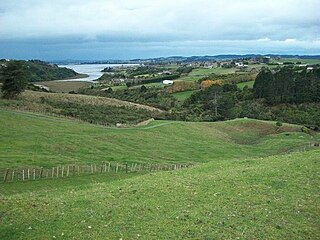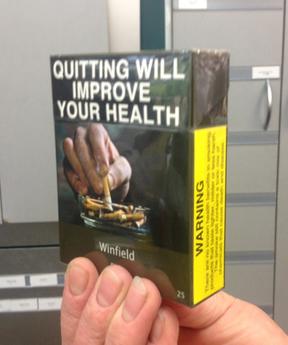
A cigarette is a narrow cylinder containing a combustible material, typically tobacco, that is rolled into thin paper for smoking. The cigarette is ignited at one end, causing it to smolder; the resulting smoke is orally inhaled via the opposite end. Cigarette smoking is the most common method of tobacco consumption. The term cigarette, as commonly used, refers to a tobacco cigarette, but the word is sometimes used to refer to other substances, such as a cannabis cigarette or an herbal cigarette. A cigarette is distinguished from a cigar by its usually smaller size, use of processed leaf, and paper wrapping, which is typically white.

The Smoke-free Environments Amendment Act 2003 is an Act of Parliament in New Zealand that prohibits smoking in all workplaces including offices, clubs, pubs, restaurants, airports, and schools.

Smoking bans, or smoke-free laws, are public policies, including criminal laws and occupational safety and health regulations, that prohibit tobacco smoking in certain spaces. The spaces most commonly affected by smoking bans are indoor workplaces and buildings open to the public such as restaurants, bars, office buildings, schools, retail stores, hospitals, libraries, transport facilities, and government buildings, in addition to public transport vehicles such as aircraft, buses, watercraft, and trains. However, laws may also prohibit smoking in outdoor areas such as parks, beaches, pedestrian plazas, college and hospital campuses, and within a certain distance from the entrance to a building, and in some cases, private vehicles and multi-unit residences.
Action on Smoking and Health (ASH) is the name of a number of autonomous pressure groups (charities) in the anglosphere that seek to publicize the risks associated with tobacco smoking and campaign for greater restrictions on use and on cigarette and tobacco sales.

Because of the damage to health due to smoking in the United Kingdom it may be the first country to ban sales of cigarettes to people born after a certain year.

Litter is a global issue and has a significant human impact on the environment. Litter is especially hazardous because it can enter ecosystems and harm a country's biodiversity. Litter is a prevalent environmental issue in New Zealand.

Tobacco politics refers to the politics surrounding the use and distribution of tobacco.

Tobacco control is a field of international public health science, policy and practice dedicated to addressing tobacco use and thereby reducing the morbidity and mortality it causes. Since most cigarettes and cigars and hookahs contain/use tobacco, tobacco control also concerns these. E-cigarettes do not contain tobacco itself, but (often) do contain nicotine. Tobacco control is a priority area for the World Health Organization (WHO), through the Framework Convention on Tobacco Control. References to a tobacco control movement may have either positive or negative connotations, depending upon the commentator.

The Smokefree Environments and Regulated Products Act 1990 is an Act of Parliament in New Zealand. The Act placed smoking restrictions on indoor spaces, banned smoking on public transport and established the Health Sponsorship Council. The bill was introduced by Helen Clark, then Minister of Health and later Prime Minister. Clark would later refer to the law as "one of my proudest achievements as a politician". It was amended by the Smoke-free Environments Amendment Act 2003, which completely eliminated smoking in workspaces, by the Smokefree Environments and Regulated Products (Vaping) Amendment Act 2020, which renamed the Act and brought it "up to date", and by the Smokefree Environments and Regulated Products Amendment Act 2022.
Smoking bans in private vehicles are enacted to protect passengers from secondhand smoke and to increase road traffic safety, e.g. by preventing the driver from being distracted by the act of smoking. Smoking bans in private vehicles are less common than bans extended to public transport or vehicles used during work, like trucks or police cars.
Smoking in China is prevalent, as the People's Republic of China is the world's largest consumer and producer of tobacco. As of 2022, there are around 300 million Chinese smokers, and 2.4 trillion cigarettes are sold there every year, 46% of the world total.

Smoking in Singapore is subjected to restrictions enacted through various legislations such as the Smoking Act, which was first enacted in 1970.

SmokinginCanada is banned in indoor public spaces, public transit facilities and workplaces, by all territories and provinces, and by the federal government. As of 2010, legislation banning smoking within each of these jurisdictions is mostly consistent, despite the separate development of legislation by each jurisdiction. Notable variations between the jurisdictions include: whether, and in what circumstances ventilated smoking rooms are permitted; whether, and up to what distance away from a building is smoking banned outside of a building; and, whether smoking is banned in private vehicles occupied by children.

Plain tobacco packaging, also known as generic, neutral, standardised or homogeneous packaging, is packaging of tobacco products, typically cigarettes, without any branding, including only the brand name in a mandated size, font and place on the pack, in addition to the health warnings and any other legally mandated information such as toxic constituents and tax-paid stamps. The appearance of all tobacco packs is standardised, including the colour of the pack.

Smoking in Greece was at the highest rate of tobacco consumption in the European Union in 2010. In 2014, Greece had the highest rate of smoking in the European Union. According to a survey published by the European Commission Day for World No Tobacco Day in 2017, 37% of Greeks are smokers and only 44% of Greeks have never smoked a cigarette, the smallest percentage in the EU. After Greece, France and Bulgaria have the next largest number of smokers with 36%. At 7%, Sweden had the lowest rate.
Smoking in Tokelau is prevalent, with ethnic Tokelauans having the highest smoking prevalence of all Pacific ethnicities. In the 2011 Tokelau Census, 47.8% of people aged over 15 were found to be regular cigarette smokers.
The Oregon Indoor Clean Air Act, also known as the Smokefree Workplace Law, is a measure passed in 1981 by the US State of Oregon prohibiting smoking in public indoor places except in certain designated smoking areas. The objective is to protect non-smokers in confined areas from second-hand smoke. Beginning on January 1, 2016, the law was extended to cover "inhalant delivery systems" such as e-cigarettes.
The Smokefree Coalition was established as a national organisation in New Zealand in 1995 to advocate for tobacco control interventions by government and non-government organisations (NGOs). Its founding organisations were the National Heart Foundation of New Zealand, the Cancer Society of New Zealand, Action on Smoking and Health, Te Hotu Manawa Māori and the Asthma and Respiratory Foundation of New Zealand. It ceased operation on 30 June 2016.

The Smokefree Environments and Regulated Products Amendment Act 2022 is an act of the New Zealand Parliament that seeks to combat smoking by limiting the number of retailers allowed to sell smoked tobacco products; ban the sale of smoked tobacco products to anyone born on or after 1 January 2009; and to discourage the consumption of smoked tobacco products. The bill passed its third reading on 13 December 2022 and received royal assent on 16 December 2022. The new National-led coalition government announced in late November 2023 that they intended to repeal the legislation.















